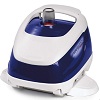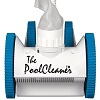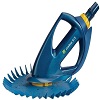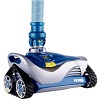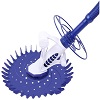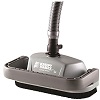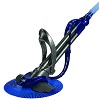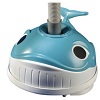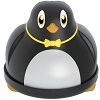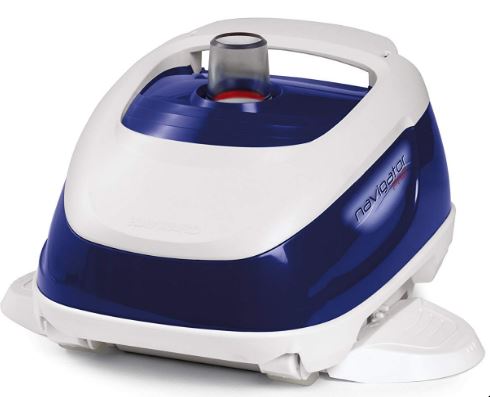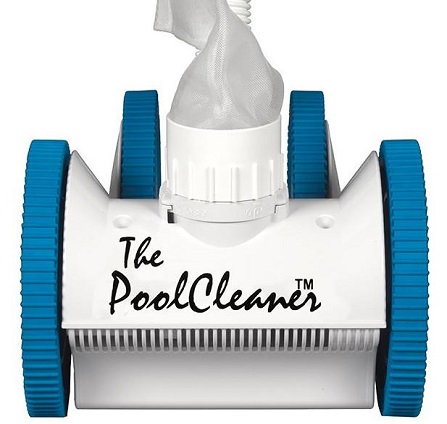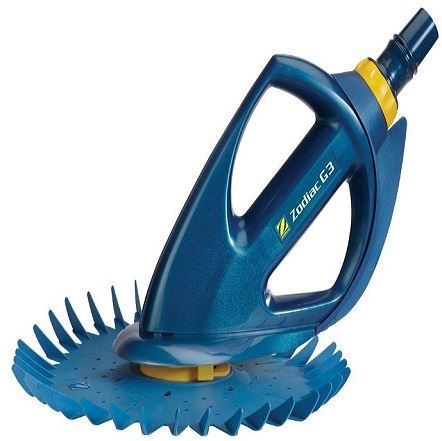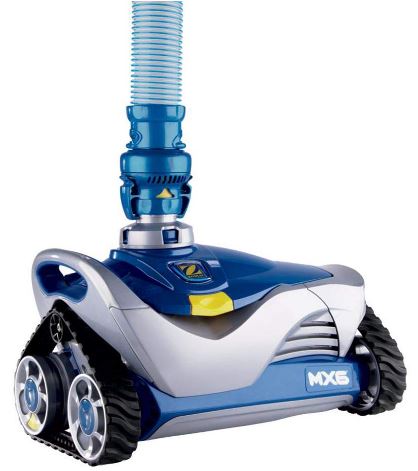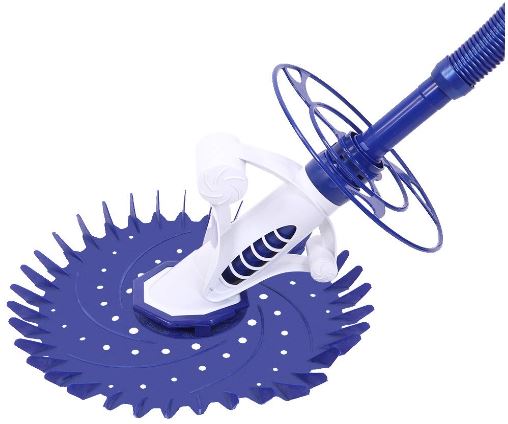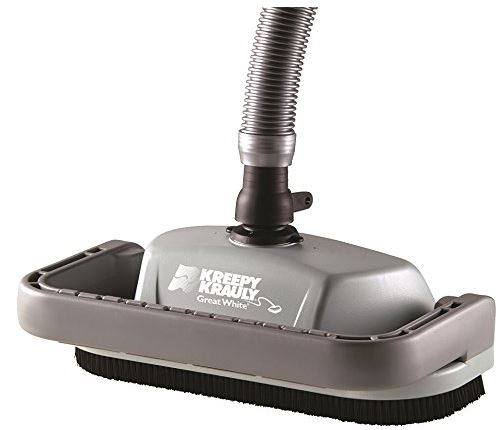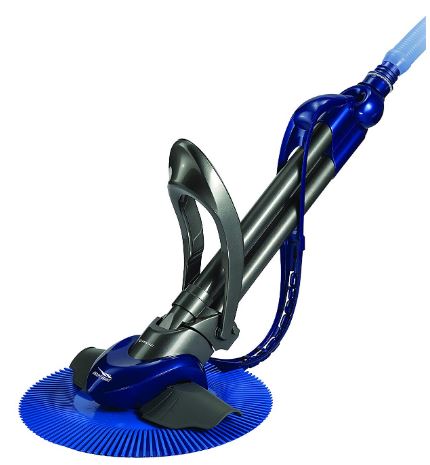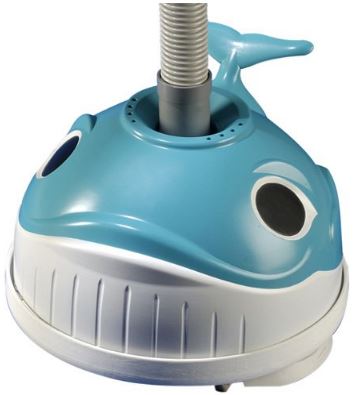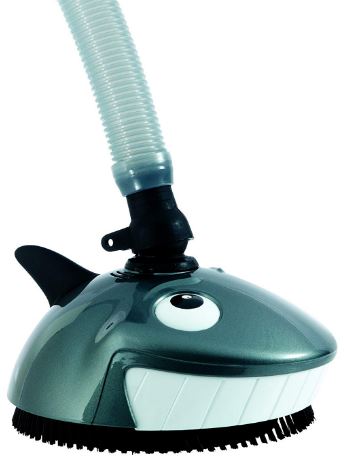Shopping for a suction pool cleaner?
You’ve come to the right place.
In this in-depth buying guide, we review and compare the best suction pool cleaners from Hayward, Pentair, and other brands.
Suction pool cleaners are generally cheaper than pressure and robotic pool cleaners.
A suction pool cleaner connects to your pool’s dedicated suction line or skimmer and uses the force of the water being sucked out of the pool to move and pick up debris.
What's In this Buying Guide
Best Suction Side Pool Cleaners
- 1. Our Top Pick: Hayward 925ADC Navigator Pro
- 2. Runner-Up:Hayward Poolvergnuegen (The Pool Cleaner)
- 3. Best Value:Zodiac Baracuda G3 W03000 Advanced
- 4. Best For An In-Ground Pool: Zodiac MX6 In-Ground Suction Side Pool Cleaner
- 5. Budget Pick: VINGLI Automatic Pool Cleaner Vacuum Pool Sweeper
- 6. Best Thorough Cleaner: Pentair GW9500 KreepyKrauly Great White
- 7. Best Side Cleaner: Pentair 360042 KreepyKrauly Suction-Side Pool Cleaner
- 8. Best For Intex Pools: Hayward 900 Wanda The Whale
- 9. Best For Above Ground Pool: Pentair 360100 KreepyKrauly Lil Shark
- 10. Fun Penguin Design: Hayward 100 Penguin
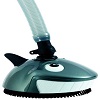
Pentair 360100 KreepyKrauly Lil Shark

- Best for above ground pools
Weight:
13.1lbsPrice:
$
The Hayward Navigator Pro’s cleaning performance, reliability, and ease of use make it our top pick. It is a bit pricey compared to other suction side pool cleaners, but it does a better job than most.
The Navigator Pro is designed for all shapes and sizes of in-ground swimming pools. It comes with 40 feet of hose lengths that are easy to link together.
The Navigator Pro connects to the skimmer or a dedicated vacuum port and uses the suction power of the pump to move around and filter water.
You may need to adjust the water flow to get it to work properly. It comes with a pressure gauge to help you do that.
Once in the water, the Navigator pro doesn’t clean randomly. It is equipped with SmartDrive steering, which directs it to take the alternating right and left turns. This ensures it covers the entire pool, including the walls.
Make sure you’ve adjusted the flow rate and flaps properly to allow the cleaner to climb the wall.
One thing we love about the Hayward Navigator Pro is that it rarely gets hung up on the wall, steps, or any other part of the pool, a common problem with other automatic pool cleaners.
As long as you’ve set it up correctly – adequate hose length, proper flow rate, etc. – you don’t have to babysit it.
It’s the main limitation, and this applies to all suction cleaners, is that it doesn’t hold debris.
Instead, it directs it to your pool skimmer or filter. So you need to clean the pool filter to ensure maximum suction power regularly.
Pros
- Excellent cleaning performance.
- Rarely gets stuck.
- Full pool coverage to the waterline.
- Relatively easy to set up and maintain.
Cons
- Requires some adjustments to work correctly.
- Easily gets clogged by large debris like leaves and acorns. You have to remove large debris before putting the cleaner in the water.
The Hayward Poolvergnuegen pool cleaner is available in two options: 2 and 4 wheels.
The 2-wheel cleaner is ideal for pools measuring 32’ by 16’ while the 4-wheel Poolvergnuegen can clean larger pools up to 40’ by 20’.
Like the Hayward Navigator Pro, the Poolvergnuegen pool cleaner has a pre-programmed steering system. It can make five types of turns between 90 and 450 degrees, which ensures there are no missed spots.
The self-adjusting turbine vanes maximize suction power at any flow rate. Even if you have a smaller pool pump (at least ½ hp) with a low flow rate, the cleaner still moves and cleans effectively.
It’s also perfect for use with a variable speed pool pump. You can set the pump on low to save energy, and the cleaner will keep chugging away and picking up debris.
Another feature we love is the adjustable skirt that allows the cleaner to maintain suction when it drives over uneven surfaces like the drain or when it encounters an obstacle.
The Hayward Poolvergnuegen easily scales the pool wall, as long as you’ve adjusted everything properly. Like other suction cleaners, it takes some trial and error to get it to work well.
Setting up the pool cleaner is relatively easy. It comes with everything you need including 40 feet of hose lengths for the 4-wheel model and 33 feet for the 2-wheel version.
Pros
- Ideal for larger in-ground pools (the 4-wheel version).
- Works with smaller and variable speed pumps.
- Full pool coverage to the waterline.
- Easy to set up and maintain.
Cons
- A bit loud.
- It requires some adjustments to get it working properly.
If you want the best deal on a suction pool cleaner, we recommend the Zodiac Baracuda. It is one of the most affordable cleaners among our picks.
Instead of wheels or flaps, the Baracuda G3 moves on a finned disk that is powered by the pump’s suction.
It sucks in water along with the debris of all sizes. Like other suction cleaners, it directs the debris towards the pool skimmer or filter. It has no onboard filter bag.
It’s a simple design, but it works well. Of course, you’ll need to skim out large pieces of debris and brush the walls and floor before putting the cleaner in the water.
The basic design has one significant advantage over other more complicated cleaners – reliability. With just one moving part, the Baracuda G3 easily lasts for years with minimal maintenance.
The cleaner is easy to install in your pool. It comes with everything you need, including hoses, a finned disk that’s safe for all types of pools, and an extra disk to replace the current one when it wears out.
It also comes with a flow keeper valve that regulates water flow to maintain maximum suction even with smaller pool pumps or a variable speed pump on a low RPM setting.
With a turn of a switch on the valve, you can use the Baracuda as a surface skimmer to remove leaves, bugs, and other debris floating on the water.
One thing you are going to love about the G3 is how quiet it is. It doesn’t have that annoying thump thump sound you get from other suction cleaners.
Even when it is close to the surface, you can’t hear it unless you are right by the pool.
Pros
- Affordable.
- Excellent cleaning performance.
- Easy to set up.
- Reliable and durable.
- Quiet.
Cons
- Sometimes gets stuck on the drain, ladder, or steps.
#4
Best for an In-Ground Pool: Zodiac MX6 In-Ground Suction Side Pool Cleaner
BEST FOR AN IN-GROUND POOL
If it were not for the attached hose, the Zodiac MX6 could easily pass for a robotic pool cleaner. It has the rugged design you normally see in Dolphin pool robots.
It even moves on tracks rather than wheels or flaps.
This makes it one of the best suction cleaners for in-ground pools. It rarely gets stuck on drains and steps and has no trouble climbing the pool wall.
Of course, it’s not drop-and-go like robotic cleaners. You’ll need to adjust the floats and flow rate to get it to climb the wall and ensure it doesn’t get stuck on the steps.
To pick up debris, the Zodiac MX6 uses cyclonic suctioning, which maintains vacuuming power even with a low flow rate. The cleaner will still work if you have a low HP pump or a variable speed pump set on low.
The MX6 comes with swiveling hoses that don’t tangle as the cleaner moves about in the pool.
It takes just a few minutes to connect the quick-connect hoses to the cleaner and a dedicated suction line or skimmer.
Watch the cleaner during the first cleaning to make sure everything is working properly.
If it seems too slow, won’t climb the wall, or keeps getting stuck, you probably have to adjust the flow rate or clean the pool filter or skimmer.
The manufacturer recommends buying the Zodiac leaf canister along with the MX6 cleaner.
The leaf canister traps leaves and other debris, preventing the skimmer from getting clogged too quickly and affecting suction power. It is especially useful if you struggle with leaves, acorns, and twigs in your pool.
The leaf catcher installs in-line between two hose sections.
Pros
- Good cleaning ability.
- Works well with low-flow and variable speed pool pumps.
- Easy to set up.
- Full pool coverage up to the waterline.
Cons
- Gears easily get clogged by larger debris like palm leaves and twigs. But the debris is easy to remove through a convenient trap door.
Suction pool cleaners are generally cheaper than other types of automatic cleaners. But the VINGLI automatic pool takes the price for affordability.
Does the low price tag mean lower cleaning performance?
Not at all. It cleans just as well as a Baracuda G3, for less than half the price. It even has the same simple one-moving-part design.
You can expect it to last for years.
It moves on a finned disk, sucking up debris as it goes. Like most other suction cleaners, it struggles to pick up large debris.
Skim the pool to removes leaves and acorns before putting the cleaner in. This will prevent it from clogging.
The cleaner requires a pump of at least ¾ hp or a flow rate of at least 1,700 gph.
Pros
- Inexpensive.
- Good cleaning performance.
- Durable design.
- Quiet.
Cons
- Gets easily clogged by leaves and other large debris.
The Pentair GW9500 KreepyKrauly Great White is one of the most aggressive and thorough suction pool cleaners.
Most suction cleaners only vacuum the pool, picking up debris that is suspended in the water. The KreepyKrauly Great White brushes and vacuums your pool.
The bottom of the cleaner has bristles that scrub and brush the surface of the pool, dislodging algae, scale, and biofilm for a more thorough clean.
So unlike other suction cleaners, you don’t have to brush the pool manually every time before you put the cleaner in the water.
Another design feature that makes the Great White the best cleaning suction cleaner is the ultra-wide 15” cleaning path. This not only allows it to pick up more debris, but it also shortens cleaning time.
The Great White provides full pool coverage, including the bottom, walls, steps, and waterline. You may need to adjust the flow rate to get it to climb the walls.
The cleaner is easy to set up. It comes with 12 hoses that easily link up.
You can connect the cleaner to your pool skimmer or a dedicated vacuum line if your pool has one. A vac port fitting is included.
Like most suction cleaners, the Great White doesn’t come with its own filter. All the debris is directed towards the pool filter, which requires regular cleaning to prevent it from clogging up.
Consider buying a leaf catcher/canister to catch leaves and other large debris before they reach the filter. It’ll ease the burden on your pool filter and reduce how often you have to clean it.
Pros
- Deep cleaning - scrubs and vacuums pool.
- Easy to set up.
- Cleans fast.
- Full pool coverage up to the waterline.
Cons
- Requires frequent pool filter cleaning to maintain suction.
It moves on a disc-like footpad, but the Pentair 360042 KreepyKrauly suction side cleaner is surprisingly agile in the pool.
It is one of the best wall-climbing suction pool cleaners. It also cleans the bottom, the steps, and the waterline. A dive float directional guidance system ensures it covers every part of the pool.
A roller strap bumper keeps the cleaner from getting stuck when it’s navigating around tricky areas such as the steps and around the ladder.
KreepyKrauly relies only on vacuuming to pick up debris. The pleated seal sucks up water along with debris and directs it to the pool filter.
You need to empty the pool filter frequently to prevent it from clogging, which can reduce the amount of suction power reaching the cleaner.
To reduce how often you have to empty the filter, get a leaf catcher, and install it in-line. It’ll trap large bits of the debris before they clog the filter.
With just one moving part, the KreepyKrauly pool cleaner is designed to last for years with minimal maintenance. There are no gears or wheels to replace or repair.
You’ll need to replace the footpad after a while, but that’s it.
Pros
- Climbs and cleans pool walls.
- Reliable and long-lasting design.
- Easy to set up.
Cons
- Only vacuums the pool. You’ll need to brush the floor and walls manually.
Wanda the Whale is the right choice if you are looking for an affordable suction pool cleaner for an Intex above ground pool.
However, you may need to upgrade your Intex pool pump. Most of the filter pumps that come with Intex pools are not strong enough to power Wanda the Whale.
Wanda uses a turbine system to regulate water flow and maintain maximum suction. Like most other suction cleaners, it only vacuums the pool.
It won’t remove stuck algae and debris, meaning you have to scrub the pool manually. Focus mainly on scrubbing the walls because Wanda only vacuums the bottom – it’s not a wall climber.
The cleaner has a pre-programmed steering system called SmartDrive that ensures it covers every inch of the bottom of the pool without getting stuck.
A Bumper ring guides it away from walls and ensures it doesn’t damage your pool when it hits the wall.
Wanda comes with everything you need to set it up in your pool, including 32 feet of hose sections. You don’t need any tools to install the cleaner.
Pros
- Affordable.
- Picks up all kinds of debris.
- It improves poor circulation.
- Easy to set up and maintain.
- Works quietly.
Cons
- Don’t clean walls and steps.
The KreepyKrauly Lil Shark suction cleaner is designed specifically for above ground pools. It has a fun shark design that your kids will love.
Lil Shark is one of the few suction cleaners that scrub and vacuum the pool, providing a deeper clean than most cleaners.
Nylon bristles underneath the cleaner scrub away at algae and stubborn debris. It then vacuums the debris for filtration by the pool filter.
Lil Shark’s wide 10” cleaning path makes for faster cleaning. It also reduces the number of missed spots to almost zero.
Because the cleaner doesn’t have its own debris bag, you must regularly check and empty the pool filter to prevent clogging and maintain suction power.
If you notice the cleaner slowing down or not moving at all, the pool filter is probably clogged.
Depending on your pool, you may need to make a couple of extra purchases to get the best out of Lil Shark.
The first is a stronger pump, ideally at least one hp. This will deliver more suction power to the cleaner, allowing it to circulate more water and pick up more debris.
But first, check how well the cleaner works with your existing pool pump. If it seems to move to slowly or constantly gets stuck, you may need to upgrade your pump.
The second purchase is an in-line leaf canister to prevent leaves and other junk from reaching your pool filter. This will extend the life of your filter and reduce maintenance work.
Pros
- Excellent cleaning performance in above-ground pools – scrubs and vacuums.
- Reliable and long-lasting one-moving-part design.
- Cleans fast.
- Easy to set up and maintain.
Cons
- Doesn’t climb walls.
The Hayward 100 Penguin is another right choice if you are looking for a suction pool cleaner with a fun design.
It’s designed to look like a penguin complete with a cute bow around its neck.
It is designed for use in above ground pools only. Hayward recommends it for permanently installed pools with a hard side.
You can still use it in an Intex or any soft-sided pool as long as your filter pump is strong enough.
If you have an Intex pool, we recommend upgrading to a 1-2 hp filter pump to ensure the cleaner has enough suction power.
Unlike the Pentair Lil Shark, Hayward Penguin does not have bristles. It only vacuums the pool.
It’ll pick up most of the debris and some of the algae at the bottom of the pool. But you’ll occasionally need to brush the sides and bottom for a deeper clean.
A pre-programmed steering system called SmartDrive ensures the cleaner doesn’t miss any spots. It also has a bumper ring to steer it away from walls and keep it from getting stuck on steps or ladder.
The Penguin cleaner is easy and fast to install. It comes with 32 feet of hose sections. That’s long enough to clean most above ground pools from small 12”-18” pools to larger ones of up to 30 feet.
If you have a larger above ground pool, you can order extra hose sections from Hayward.
Pros
- Affordable.
- Picks up all kinds of debris.
- Easy to install and maintain.
- Fun design.
Cons
- Doesn’t scrub the pool; only vacuums.
- It doesn’t clean the walls.
Buyer’s Guide: Things To Consider When Choosing a Suction Pool Cleaner
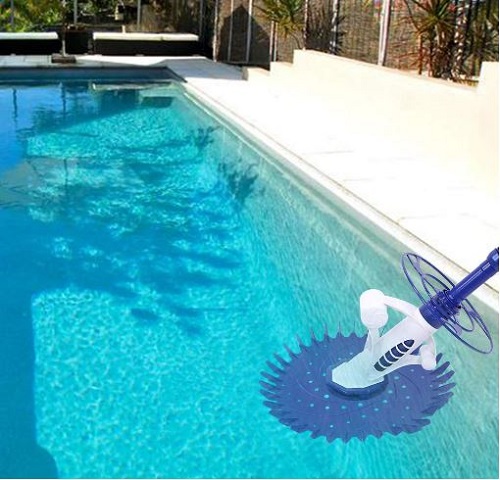
Type of Suction Cleaner
Suction cleaners come in different styles and designs. Here are the most common varieties you’ll come across.
Belt drive: Some suction cleaners use a belt to operate the wheels or turn the turbine. Belt drive systems require little maintenance and can last a long time. They are also very quiet.
Gear drive: Other suction cleaners use gears instead of a belt system. The gears tend to wear out quickly, requiring regular replacement.
Chain drive: This is like a belt drive system, only that it uses a chain. A chain drive system is more durable and requires minimal maintenance.
Diaphragm pool cleaner: This is the simplest type of suction pool cleaner. These cleaners rely on a single part called a diaphragm to regulate water flow and create suction. With just one moving part, these cleaners are easy to maintain and last for years. KreepyKrauly pool cleaners belong to this category.
Swimming Pool Type, Size, and Shape
One of the first things to check when buying a suction pool cleaner is the type of pool it’s designed for.
Many in-ground suction cleaners can also be used in an above-ground pool, but you’ll need to reduce the hose length.
However, some in-ground cleaners can’t work in an above ground pool, and some above-ground cleaners are not ideal for use in an in-ground pool.
Something else to check is the recommended pool size. Most suction pool cleaners can clean a standard 32′ by 16′ swimming pool.
If you have a larger pool, you can usually add more hose lengths to get full coverage. If your pool is smaller, don’t use all the hose sections to prevent tangling.
The shape of your pool doesn’t matter. Suction cleaners can clean a rectangular, round, or free-form pool.
Most models have a pre-programmed steering system that ensures they don’t miss any areas.
Filtration Rate
A higher filtration rate means the cleaner works faster and circulates pool water more effectively.
But remember that the filtration rate also depends on how powerful your pool pump is. A cleaner with a high filtration rate won’t help much if you have a weak pump.
That’s why it’s a good idea to check the minimum recommended pump size or flow rate.
Can Work with Low Flow or Variable Speed Pumps?
If you don’t want to spend extra money upgrading your pool pump, look for a suction cleaner that can work with your existing pump.
Some cleaners are designed to maintain good suction even with a low flow rate.
These types of cleaners are also great if you have a variable speed pump. You can reduce the pump’s RPM, thus reducing energy usage, and the cleaner will still work fine.
Boost Pump Required?
Most suction cleaners don’t need a booster pump. All our picks above work perfectly well with your existing pool pump.
However, if you have a low-flow pool pump, you may need to upgrade it to something more powerful to match the manufacturer’s flow rate requirements.
Vacuum-Only vs. Vacuum & Scrub
Most suction pool cleaners only vacuum. They suck debris-leaden pool water into the hose that connects to your pool’s filter.
They do a good job cleaning the pool, but you’ll need to occasionally brush the walls and bottom to loosen algae and stubborn grime.
If you don’t want to do any manual brushing, get a suction cleaner that scrubs and vacuums. It’ll have bristled at the bottom that loosens algae and dirt as the cleaner moves.
You may still need to brush certain spots like the steps and corners, but the cleaner greatly eases the amount of cleaning you need to do.
Size & Weight
Suction pool cleaners come nowhere close to the weight and size of a robotic pool cleaner. You don’t have to worry much about having difficulty lifting the cleaner in and out of water.
But it’s still a good idea to check how heavy the cleaner is if you are not very strong or have mobility problems.
Type of Dirt & Debris
Most suction cleaners do a good job picking up all kinds of debris from fine sand and algae to leaves and acorns.
But a few struggles with larger debris like twigs and leaves. They’ll quickly clog up if you don’t skim out the debris first.
If your pool fills up with leaves, acorns, and other large debris, look for a suction cleaner that can handle them without clogging or getting stuck. It should have a large vacuum port that allows the debris through.
Ability to Clean Walls & Steps
If you don’t want to spend your weekends scrubbing the walls and steps, look for a suction cleaner that can climb the pool walls and clean the steps.
Many in-ground suction cleaners are designed to provide full pool coverage, including steps, walls, and waterline. But you’ll likely need to make a few adjustments to the flow rate and weights to get the cleaner to clean all these areas without getting stuck.
Noise
Unless your pool is a good distance from the house, avoid pool cleaners that make a constant thump thump sound when cleaning. It can get annoying, especially at night.
The best suction cleaners work quietly. You won’t realize it is cleaning until you see it moving about.
Note: Most suction cleaners will make a bit of noise when they are cleaning the wall close to the water’s surface.
Easy to Setup
You should be able to set up the cleaner yourself in less than 15 minutes with no tools. Check that the cleaner comes with everything you need, including adequate hose sections.
Price
Suction pool cleaners start at around $100-$200, cheaper than robotic and pressure pool cleaners.
The best ones cost between $200 and $500.These offer the best cleaning performance and reliability. They also last longer, with some iconic brands like KreepyKrauly lasting for a decade or more.
Optional Upgrades
Leaf catcher/canister: An in-line leaf canister keeps the pool filter from clogging too quickly. It extends the life of the filter and reduces maintenance work.
Pool pump: Upgrading to a more powerful pool pump will increase filtration rate, cleaning performance, and poor circulation.
Extra hose lengths: Necessary if your pool is longer than the length of the hoses that come with the cleaner.
Suction Pool Cleaner FAQs
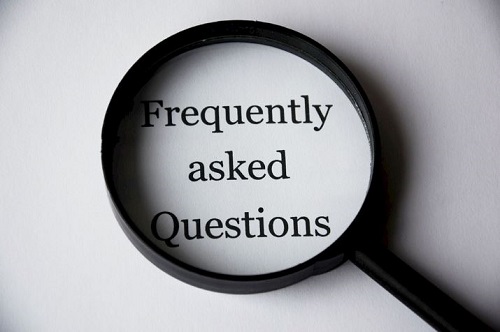
How To Install A Suction Pool Cleaner?
A suction pool cleaner connects to your pool skimmer or a dedicated vacuum line if your pool has one.
Start by connecting the leader hose to the pool cleaner and then connect the remaining hose lengths. Put the cleaner in water and lower the hose a bit at a time, letting all the air bleed out.
Turn off your pool pump and remove the skimmer basket then connect the hose to the skimmer using the provided adapter. If your pool has a dedicated suction line, you can also use that instead of the skimmer.
Turn on the pool pump and check that the cleaner is moving properly – no too fast but not too slow either.
If it’s not moving well or is not moving at all, you’ll need to adjust the flow rate, either using a pressure gauge or by measuring wheel RPMs.
How To Operate a Suction Pool Cleaner?
Once you’ve installed a suction pool cleaner, it’ll work on its own. But you need to watch it, in the beginning, to make sure it is not getting stuck on the steps or drain.
Depending on how it’s moving, you may need to adjust the weights or flow rate.
Suction cleaners have no filter bag, so there’s no debris bag to empty. But you’ll need to regularly clean the pool filter since it handles all the debris from the cleaner.
If you let filter hold too much debris, it will clog and reduce suction power. The cleaner will move slowly or stop moving completely.
How To Maintain a Suction Pool Cleaner?
At least once a day, remove the cleaner and check for leaves and debris stuck in the gears, wheels, and other parts.
Every month, check the cleaner for cracks and wear. Replace whatever parts need to be replaced.
Robotic vs. Pressure vs. Suction Pool Cleaner: What’s the Difference?
Suction cleaners: These cleaners rely on your pool pump’s suction power to move and pick up debris. They connect to the pool skimmer or a dedicated vacuum line. Suction cleaners also rely on the pool filter to catch debris.
Pressure cleaners: These pool cleaners use the force of water coming back into the pool to move and pick up debris. They connect to a dedicated return line. Pressure cleaners have an onboard filter bag to catch debris. They rely only on the pool pump, not the filter.
Robotic cleaners: These cleaners are fully self-contained. They don’t rely on either the pool pump or the filter. They have their own internal mobility system and an onboard filter bag or basket. Robotic pool cleaners are generally more expensive than suction and pressure cleaners.
Can I leave a suction pool cleaner in the pool?
Yes, you can. Most pool owners find it easier to leave the pool cleaner in the pool, so they don’t have to keep connecting the hoses every day.
But remove the cleaner when you are swimming and when you are adding chemicals.
Conclusion
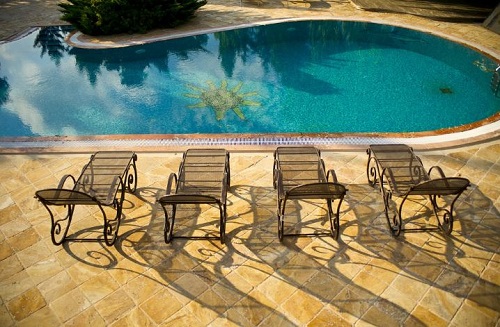
Suction pool cleaners are great for pool owners who don’t want to spend a lot of money on an automatic pool cleaner.
They are easy to set up and easy to maintain, as well. Though you still need to do some cleaning, a suction cleaner makes pool maintenance much easier, less time consuming, and cheaper.

